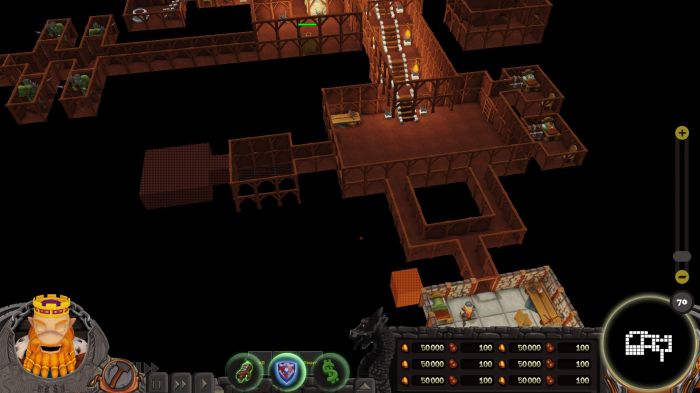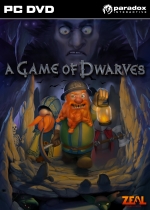
A Game Of Dwarves Review
A Game of Dwarves takes its cues from classic sim management games such as Theme Hospital and Dungeon Keeper. Rather like that latter title, the aim in A Game Of Dwarves is to develop an underground settlement, keep your minions happy, research technology, mine for resources and kill invaders. The difference here is that while Bullfrog had you managing imps, trolls and bile demons, in Zeal Studios' title your minions are dwarves, dwarves and more dwarves.
Of course, each dwarf in your settlement plays his own specific part in proceedings. All dwarves are unspecialised when you first recruit them into your clan and until they are given a job they do little more than wander about, eating through your food supplies and sleeping in the beds you've lain down for your more useful citizens. At any point though you can give assign them a purpose, such as making them a researcher, digger, warrior, crafter or worker. Each dwarf type is integral to your settlement's survival - workers gather food, crafters build your structures and warriors protect your settlement from orcs, spiders, rats and the more nefarious creatures dwelling in the depths.

There is further specialisation down the line, as all dwarves gain experience levels by performing the tasks associated with their career, except as-yet unspecialised dwarves who gain experience by watching others work; gaining experience makes each dwarf faster and more efficient in his duties. Warrior dwarves are a little different, as when they gain experience through fighting or training they can further specialise (if the research requirements are met) into fighters and spearmen, then even further into shield bearers, berserkers, crossbowmen and musketeers. So, despite 'only' having dwarves to draw from in your dungeon there is a nice variety of denizen types to manage.
As well as your citizens, one final dwarf takes part in proceedings, the Prince. This dwarf is your avatar in the game world and represents the main character for the game's narrative, a story about reclaiming the lost lands of your people from the evil mages, to whom the dwarves lost a war in ages past. The Prince starts off as little more than a worthless drain on your food resources, but soon evolves into strong and useful character. By completing mission objectives, including optional objectives he is awarded equipment and influence points. Equipment has immediate and specific effects and influence points are used to level up his abilities.
There are three skill trees available to the Prince and it is the player's choice how to develop the character. The military skill tree transforms the Prince into a powerful fighter and improves the abilities of his warrior dwarves. A management skill tree is available which improves resource collection and lowers the costs of construction. Finally, the last skill tree boosts research ability, improving the skills of your researchers and granting bonus technologies in each mission. The Prince can be made into a jack-of-all trades or can be specialised in a specific area, whatever the player chooses.
The aim of the Prince and his clan of dwarves in any given mission is to create a suitable settlement, build up the clan and then explore the surrounding area to complete objectives. Unexplored underground areas are highlighted on the screen with question marks, so you have an idea of areas of interest you should be digging towards. Building your settlement and exploring your surroundings isn't just done on one level, as you will dig upwards towards the surface and down towards the depths, eventually ending up with a dungeon that corkscrews through the earth as it spirals downwards.

Keeping track of multiple levels can get very confusing after a while and the game does little to give you any visual or audio warning if you've managed to tunnel a dwarf into an inescapable hole, so it really requires some careful consideration to make sure you've covered all routes. In fact, the game does very little to warn you about anything so it's crucial to keep your eye on where your guys are tunneling, lest they uncover enemies or get trapped, as well as your happiness levels, food levels and wealth. A visual or audio cue here or there to let you know something important needs your attention would have been a welcome addition.
The central problem with A Game Of Dwarves is the pacing; this game is incredibly slow paced throughout and while this can lead to a relaxing and unpressured experience when building it also tends towards great frustration when trying to progress the game. Exploration is key in every mission, firstly to obtain the various resources required to function and secondly to explore surrounding areas of interest and to move the story forward. Not only are your dwarves extremely slow at mining to begin with, but they constantly take breaks to eat and sleep.
The time they take to eat and sleep is painfully long. They walk very slowly to begin with and if you are working some distance away from your main settlement it takes a while to get to where they are going, although you can speed their commute up with a quick teleport. It doesn't take too long to eat, but when dwarves sleep they do so for a painfully long time. Want to dig a corridor? Fine, but be prepared for your digger to eat four meals and take three snoozes in between short bouts of activity. Even with the game running on maximum speed this can result in several minutes of simply staring at the screen patiently and considering digging is where you spend most of your time this can become very old, very fast.
The majority of your game will be spent at this exploration stage, as creating the settlement is the easy part. One mid-sized farm of underground plants with three or four workers is enough to provide up to 20 dwarves with enough food. Put down a table on which to store the food, drop a few beds around and set up a research table and you have pretty much all you need to function. All of these things can even be put in a single room, so if you aren't bothered about aesthetics your main settlement can be a tiny and cramped place.

Not that your dwarves will care; they do have a 'happiness' rating which can be improved with such decorations as statues, plants, floor tiles and wall tiles and spending money on these will keep them happy, but bizarrely they do not seem to care where they are placed. You can leave your settlement completely bland and undecorated as long as you have dropped resources into building statues, hanging pictures and tiling the walls in a far corner of your dungeon, even somewhere nobody ever visits. For some reason this will be enough to keep everyone satisfied no matter the squalor of their living conditions.
If you do need to expand beyond this you may need to set up another farm, another table and some more beds to keep everyone happy. Food tables don't need to be near the farms though, as the food harvested will automatically populate the tables without the need for your dwarves to carry it back and forth. The fact that you can cram everything together without worrying about supply lines between your food and the tables means designing a settlement is a simple task that requires very little thought. You certainly can spend time honing the fine details and making it nice to look at, but there is no real need to go beyond the basics.
In terms of resource collection, this goes beyond the simple need for gold aa different upgrades and constructions require the use of differing resources. Money is earned by mining gold, silver and platinum blocks, food and wood are grown on special underground plants and rarer resources such as marble and titanium can be found and extracted when exploring the depths. The fact that there are so many resources to choose from and each is required for different buildings is interesting, but ultimately the higher-tier constructions are not necessary by the time you delve deep enough to find the resources that they require. You can also buy from and sell resources you have collected to the wider dwarf kingdom.
A typical mission of A Game Of Dwarves will follow the same principles. You'll start off by creating your settlement, hiring dwarves and putting a few decorations down. This is the fun part, but is also the part that is over the quickest. Following that is the long slog to carefully dig your way down, uncovering areas of interesting and letting your warriors kill any enemies that are uncovered. You can't dig in too many places at once in case your warriors get overwhelmed and you have to give them time to recover after a fight. Add to this how slow your diggers are plus the amount of rests they need to take and you'll be spending a lot of time pressing the fast forward button and still not getting anywhere fast. Eventually you reach the last room and normally have a big fight with nasty enemies, then the next mission starts and you do the same thing again.

A Game Of Dwarves is not terrible by any stretch. The Dwarves are cute with a lot of variety between them, developing your Prince adds a lot to the experience, the campaign is lengthy, a custom game mode is available and it can be fun to spend time building a great settlement, even if you don't really need to. Unfortunately the game finds itself held back by an unforgivingly slow pace and the simplicity of the mechanics make it far too easy to exploit. As a low priced indie title it may be worth a glance for those interested in the genre, but it is certainly not the spiritual successor to Dungeon Keeper that many of us were hoping for.
A Game of Dwarves (Reviewed on Windows)
Game is enjoyable, outweighing the issues there may be.
A Game of Dwarves takes its cues from classic sim management games such as Theme Hospital and Dungeon Keeper. Rather like that latter title, the aim in A Game Of Dwarves is to develop an underground settlement, keep your minions happy, research technology, mine for resources and kill invaders.







COMMENTS
Kaostic - 11:36pm, 3rd April 2015
Great review, Ewok. I used to be huge fan of the dungeon keeper series. I'd love to get into this but don't have the time just yet!